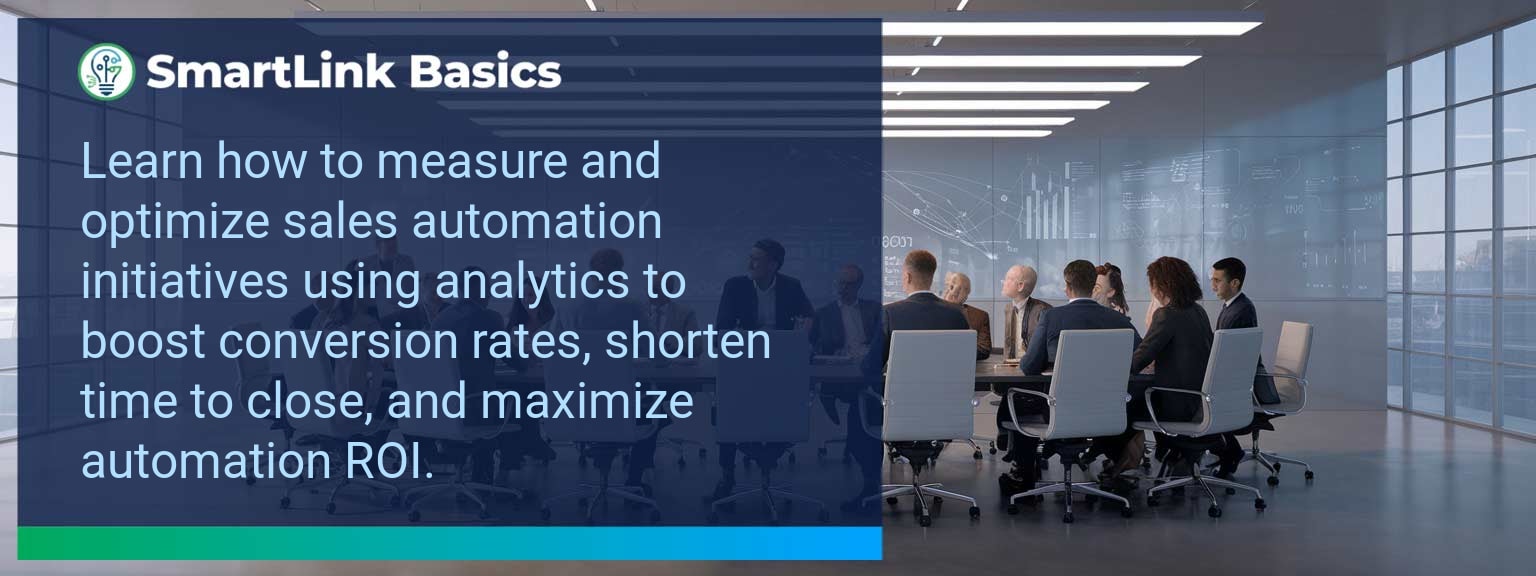Industry data shows that organizations adopting AI-driven automation achieve cost reductions of up to 30% while accelerating sales cycles by 20% or more (McKinsey, 2024). For sales leaders, AI automated workflows now define competitive advantage, enabling teams to reallocate time from repetitive tasks to high-value engagements. At SmartLink Basics, we help decision-makers implement these systems strategically, ensuring they integrate with existing revenue operations. In this article, you’ll see how AI automated workflows power business outcomes, the common obstacles that slow adoption, and practical steps to optimize processes. You’ll walk away with proven examples, a 90-day action blueprint, and measurable KPIs to track results.
- Automate repetitive administrative and CRM updates with AI.
- Integrate machine learning to personalize outreach at scale.
- Streamline approvals, quotes, and contract workflows for speed.
- Use predictive analytics to prioritize sales opportunities.
- Track adoption and performance with targeted metrics.
AI Automated Workflows: What Changed and Why It Matters
AI adoption has shifted from experimental to operational, making automated workflows a standard in high-performing sales organizations. The real advantage lies in combining workflow automation with artificial intelligence workflows to optimize every step of the revenue process. Sales leaders now use AI to synchronize touchpoints, reduce manual inputs, and ensure faster execution. For example, a B2B SaaS leader introduced automated lead enrichment and routing, cutting qualification time by 60%. Actionable insight: Audit processes for time-intensive handoffs and apply AI where repeatability is high.Redesign the Revenue Operating System With AI Automated Workflows
ICP, Segmentation, and Targeting AI-enabled segmentation uses historical wins, firmographic, and behavioral data to dynamically update ICP profiles. This ensures targeting precision without quarterly re-work. Pipeline Architecture Automated workflows push opportunities through the right stages based on engagement signals. AI flags at-risk deals for intervention. Plays and Messaging Integrated automation tools deliver personalized sequences based on buyer activity, increasing relevance at every touchpoint. Operating Cadence AI schedules follow-ups, forecast calls, and account reviews based on actual pipeline movement rather than static calendars. Actionable insight: Implement automation that adapts in real-time to both internal and buyer-driven events.Common Obstacles To Achieving Seamless Automation
The most frequent challenges are fragmented systems, inconsistent data quality, and cultural resistance. Without a unified data layer, automation amplifies errors rather than solving them. Coca-Cola Europacific Partners reported needing a full data governance upgrade before AI could improve sales workflows. Leaders must first assess infrastructure readiness and train teams to trust AI-influenced recommendations. Actionable insight: Before deployment, establish clean data practices and a single source of truth.Implementing AI To Optimize Workflows
Effective deployment of AI process optimization starts with mapping current-state processes, identifying friction points, and matching them with automation tools. For example, automating proposal generation based on CRM opportunity data can reduce turnaround from three days to one hour. Solutions combining business process automation platforms with machine learning integration enable continuous performance improvement. Actionable insight: Pilot in one high-impact stage, measure, and then expand.Tangible Benefits From Automated Processes
The benefits extend beyond time savings — sales leaders gain a scalable system. Tangible outcomes include faster quote-to-close, higher lead conversion, and better forecast accuracy. A manufacturing firm implemented AI-assisted order processing and cut errors by 40%, improving on-time delivery rates. Actionable insight: Track both speed and accuracy to measure workflow automation effectiveness.Metrics That Matter
| Category | Metric | Definition | Target |
|---|---|---|---|
| Leading | Workflow Completion Rate | % of automated sequences executed without manual intervention | 95%+ |
| Leading | AI Suggestion Adoption Rate | % of AI-generated action recommendations executed by reps | 80%+ |
| Lagging | Cycle Time Reduction | Decrease in time from lead entry to closed-won | 20%+ |
| Lagging | Revenue Per Rep | Average sales revenue generated per sales rep per quarter | +15% YoY |
| Quality | Automation Error Rate | % of workflows that trigger incorrect outcomes | <1% |
| Quality | Customer Satisfaction Post-Automation | Average CSAT score after automation implementation | ≥ 4.5/5 |
Innovations And Next Steps For AI Automation
Emerging capabilities like AI-generated playbooks, intent-driven dynamic routing, and integrated AR for virtual product demos are shaping the next wave of sales automation. Companies integrating these tools early will outpace competitors in speed and personalization. Actionable insight: Stay ahead by testing emerging automation features quarterly and aligning them with evolving buyer expectations.Get the 90-day plan, coaching rubric, and dashboard template to operationalize AI in your enablement program.
Turning AI Automation Into a Revenue Multiplier
AI automated workflows are now a strategic lever for predictable, scalable growth. This guide outlined current applications, adoption challenges, a 90-day execution plan, and measurable success criteria. To make automation pay off, sales leaders should integrate tools into one cohesive operating system and review results monthly for continuous improvement. Access more AI-driven sales enablement resources from SmartLink Basics to design a high-performance automation strategy. Sales leaders who consistently achieve targets share one defining skill: the ability to build and sustain resilient, high-performing teams. According to data from the Sales Management Association, companies with strong sales leadership processes outperform peers by more than 20% in annual revenue growth. At SmartLink Basics, we emphasize that mastering sales leadership strategies is not about more meetings or bigger quotas—it is about establishing a framework that fuels performance and adaptability. This article explores the barriers slowing teams, the methods to break through them, and the measurable actions that turn high-output performance into a reliable system.- Remove operational bottlenecks that slow sales cycles
- Align team incentives with measurable performance drivers
- Establish clear sales process governance and accountability
- Implement targeted coaching to strengthen resilience and skills
- Track leading and lagging indicators to ensure sustained growth
Overcoming The Barriers To Sales Growth
Performance plateaus often come from misalignment between leadership expectations and frontline execution. Even the most talented team can stall without a shared understanding of priorities and a consistent operating rhythm. A common barrier is process clutter—multiple, conflicting workflows that reduce momentum. Another is lack of timely feedback, which delays course correction. Successful leaders use structured sales team leadership frameworks to minimize these inefficiencies. For example, a regional B2B SaaS provider cut its average sales cycle by 18 days by replacing four separate CRM protocols with one standardized process. The immediate clarity allowed reps to spend more time on qualified opportunities and less on admin work. Actionable Insight: Conduct quarterly audits of your sales process, removing steps that do not directly advance deals or improve win probability.Implementing Effective Sales Leadership Strategies
Strong sales leadership strategies integrate structural design with the day-to-day coaching that builds resilience. Leaders must drive clarity in four key areas: ICP, Segmentation, and Targeting: Define your Ideal Customer Profile and segment markets by potential rather than convenience. Focus resources where buyer readiness and deal size align. Pipeline Architecture: Design a uniform pipeline with explicit stage definitions, probability weightings, and forecast accuracy checks. Plays and Messaging: Equip teams with tested outreach frameworks and objection-handling language tailored to each segment. Operating Cadence: Create a predictable schedule of 1:1 coaching, deal reviews, and performance checkpoints that reinforce discipline. Example: A manufacturing sales division achieved a 25% improvement in close rates by shifting from static monthly reviews to weekly, focused deal inspections. Actionable Insight: Document your four-part operating framework and train your managers to execute it on a consistent cadence.Measuring The Impact On Team Performance
Continuous measurement ensures that leadership efforts generate measurable results. Mature leadership in sales involves balancing leading indicators such as activity volume and pipeline velocity with lagging results like booked revenue. Here is a simple framework to monitor and adapt:| Category | Metric | Definition | Target |
|---|---|---|---|
| Leading | Pipeline Velocity | Average days from lead to close | Reduce by 15% |
| Lagging | Quarterly Revenue | Total closed ARR per quarter | Exceed target by 8% |
| Quality | Customer Retention Rate | Percentage of customers retained year-over-year | Above 92% |
Sustaining Excellence Through Continuous Development
Sales performance improvement is not a one-time initiative. Top-performing leaders invest in ongoing leadership skills development and adaptive team motivation techniques. Interactive coaching, real-time feedback tools, and peer-led best practice exchanges keep skill growth aligned with market changes. Coaching sales teams to recover quickly from setbacks directly builds sales resilience and future-proofs the organization against volatility. Example: A financial services firm reduced turnover among top performers by pairing them with emerging reps for structured peer mentoring. Actionable Insight: Schedule structured, quarterly skills audits and align training content to identified performance gaps.Get the 90-day plan, coaching rubric, and dashboard template to operationalize AI in your enablement program.
Effective sales leadership creates a repeatable, measurable system for driving performance. Leaders who align strategy, process, and coaching amplify both results and resilience, setting their teams up for sustainable success.









